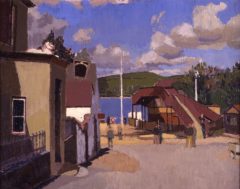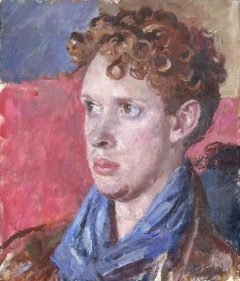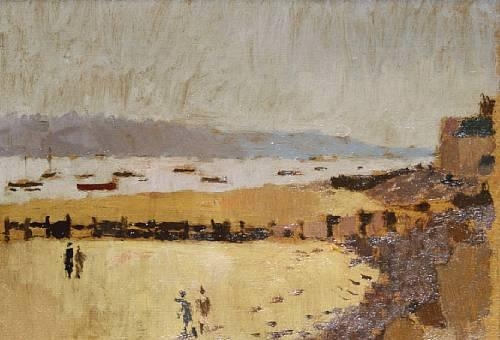Bankside brothers in art – where Welsh poet and painter found inspiration
Beach and Tywi Estuary at Ferryside, 1930s, Edward Morland Lewis. (Carmarthenshire Museums Service Collection.)
Edward Morland Lewis, who died of malaria while on active service in Tunisia in the North African campaign in 1943, aged 40, deserves to stand in a brighter spotlight, alongside Welsh landscape artists of the early 20th Century, a period dominated in the public mind by far better-known painters such as Augustus John, and his sister Gwen.
Bankside brothers in art – where Welsh poet and painter found inspiration
Two artists found inspiration on the opposite banks of the river Tywi in Carmarthenshire, West Wales. The one, we’ve all heard of. Dylan Thomas wrote one of the classics of 20th-century poetry, Fern Hill, recalling memories of his childhood summers spent on a farm above the long winding estuary. The other, Edward Morland Lewis, far less known today, was born and painted within sight of Thomas’s holiday haunts.
A dozen or so of his works feature the beach at Ferryside and views over the Tywi Estuary. They are a visual arts complement to the life, times and geographical inspiration of Dylan Thomas (11 years younger than Lewis), who also stayed in and around Llansteffan, another of Lewis’s subjects, directly over the estuary. Lewis also painted in nearby Laugharne, the most settled of Thomas’s many homes.
Lewis, who died of malaria while on active service in Tunisia, in the North African campaign in 1943, aged 40, deserves to stand in a stronger spotlight, alongside Welsh landscape artists of the early 20th Century, a period dominated in the public mind by far better-known painters such as Augustus John, and his sister Gwen.
The Welsh artist studied under Sickert, and established himself as a proficient painter during his short life. He is best known for his landscapes, in which he used bold blocks of colour over a warm underpainting.
Much of his work is held in public collections (100 paintings in total). His creations are on display in the galleries in Carmarthen, Swansea and Newport, the National Museum of Wales, the Pallant Gallery in Chichester, Manchester Art Gallery and elsewhere. An unusual departure from his usual subject matter of seaside towns, which he painted in Ireland, northern France and Spain, as well as South Wales, is one of his final landscapes, High Wycombe (1938), a study of Chilterns forest. It is in the collection of the Bushey Museum & Art Gallery in Bushey, Hertfordshire, 25 minutes by train from Euston Station.
Born in Ferryside, Morland Lewis was the son of a competent water colourist, Benjamin Archibald Lewis, a Ferryside solicitor. He became manager of the Carmarthen Gas Works, like his father before him.

Ferryside railway station, 1930s, Newport Museum and Art Gallery.
The younger Lewis trained at St John’s Wood School of Art and at the Royal Academy Schools, London, where he met the famous artist Sickert. Morland Lewis went on to work under Sickert as an assistant. In 1930 he joined the London Artists’ Association and exhibited with this group until it disbanded in 1934. He joined the staff of Chelsea College of Art, where his colleagues included Henry Moore, Graham Sutherland and John Piper. He was exhibited at the ‘Artists of Fame and of Promise’ exhibition at the Leicester Galleries, London in 1940.
One person to recognise Lewis’s talent was Kenneth, later Lord, Clark, who compiled the monumental BBC series Civilisation in the early 1970s. He acquired one of the Welsh artist’s works, The Bandstand, in 1931 and later presented it to the Tate, which holds it now. (Most galleries own many more paintings then they can display, and outside the Welsh galleries this, unfortunately, is the case with Lewis’s works.)
Lewis is, in a strictly temporal sense, an artist from another age. Yet there are details in his paintings, a dozen or so of which feature the beach at Ferryside, the village itself and the Tywi Estuary, which can be referenced today. The main London to Carmarthen and West Wales railway runs above the long sandy strand, and his viewpoints for his beach scenes in Ferryside can easily be recognised from the train.
A fascinating link with the present is his study of the village’s railway station (Newport Museum and Art Gallery), which the Lewises, father and son, must have used every day to travel to work and (secondary) school. Remarkably it looks much the same today, 90 years later. The original signal box is still there, and the old-fashioned semaphore signals he depicted still stand at the entrance to the station.

Dylan Thomas, by Augustus John, Amgueddfa Cymru — National Museum Wales
It’s only a few miles from Ferryside across the estuary to Fern Hill, the farm at Llangain which was owned by Dylan Thomas’s aunt, Annie. (In Lewis’s painting, above, it would be situated roughly in the middle of the hill, on the other side of the estuary.) Thomas wrote Fern Hill during the war. Published in 1945, it is a joyful evocation of his childhood holidays at the farm, one of his greatest poems and a classic of the 20th Century. Thomas and Lewis may never have met, but their shared affection for this corner of Carmarthenshire is palpable.
